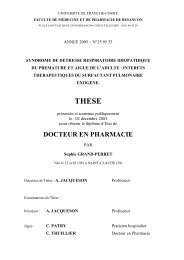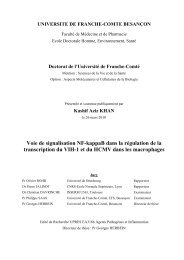THÈSE - Université de Franche-Comté
THÈSE - Université de Franche-Comté
THÈSE - Université de Franche-Comté
You also want an ePaper? Increase the reach of your titles
YUMPU automatically turns print PDFs into web optimized ePapers that Google loves.
attention to their work, and also adds internal integrity to the Journal’s themes. However<br />
I would like you to accomplish this whilst cutting back on the total number of references<br />
cited to around 50.<br />
We have removed 17 references from the text. We also have replaced three of them with<br />
others from recent papers of the Journal of Applied Ecology.<br />
Referees' comments<br />
Referee 1<br />
Comment 1 : The discussion is too long and could be summarised more clearly. In<br />
particular, it would be helpful for the <strong>de</strong>scription of local farming practices (lines 324-<br />
335) to be placed earlier in the discussion. It is in this section that we discover that<br />
autumn grazing = more cutting. This means that factors that cause high max <strong>de</strong>nsity (aut<br />
graz) and least <strong>de</strong>lay (cutting) are linked and that areas managed to produce hay have<br />
the least <strong>de</strong>lay and peak higher. This high peak in areas with low grazing is also shown<br />
in<strong>de</strong>pen<strong>de</strong>ntly by the high <strong>de</strong>nsity study sites. Thus, the different parts of the study could<br />
be combined and summarised much more clearly.<br />
This section has been synthetized and re-structured.<br />
Comment 2 : In the summary it <strong>de</strong>scribes the study as covering the early increase phase,<br />
yet 4 years appears to cover the entire increase phase. In<strong>de</strong>ed <strong>de</strong>clines can be seen in<br />
Figure 2.<br />
This is now taken into account. We consi<strong>de</strong>red A. terrestris relative <strong>de</strong>nsities from low<br />
<strong>de</strong>nsity to the maximal value in or<strong>de</strong>r to obtain a study period which coinci<strong>de</strong>d with the<br />
increase phase of an A. terrestris population cycle. Then, to make the study period clearer<br />
for the rea<strong>de</strong>r, we replaced “the early stages of the increase phase” with simply “increase<br />
phase” in the entire manuscript.<br />
Comment 3 : On page 7, line 166 it states that parcels were selected where T. europaea<br />
was absent yet the T. europaea <strong>de</strong>nsity was then monitored in these parcels (?)<br />
This section of the MM has been re-written accordingly: page 7, lines 178-184.<br />
Comment 4 : On page 7, line 169 ‘inclu<strong>de</strong>d’ should be ‘inclusive’<br />
This has been corrected: page 7, line 183.<br />
Comment 5 : Page 7, line 178 should be changed to ‘…. Selected to investigate either<br />
grass or soil distrubances’. At present it is difficult to un<strong>de</strong>rstand the methodology for<br />
examination of the high <strong>de</strong>nsity phase. Similarly table 2 could be ma<strong>de</strong> clearer by<br />
splitting the rows for ‘grazing’ from the rows for ‘soil work’.<br />
July 05 A. terrestris and farming practices<br />
C. Morilhat, N. Bernard, C. Bournais, C. Meyer, C. Lamboley and P. Giraudoux<br />
2









